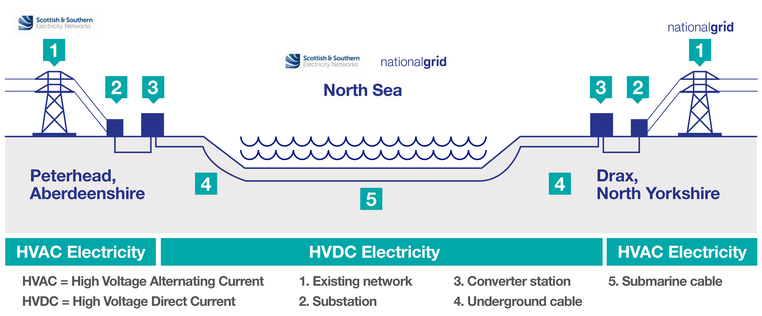Bam-Hitachi to build converter stations for UK’s ‘largest electricity transmission project ever’

This post was originally published on this site
Bam-Hitachi Energy joint venture has been appointed by National Grid Energy Transmission (NGET) and SSEN Transmission to build the converter stations for the £2.1bn Eastern Green Link 2 (EGL2) offshore interconnector between Scotland and England.
EGL2 is an “electricity superhighway” connecting Peterhead in Scotland with Drax in England with 525kV, 2GW high voltage direct current (HVDC) subsea cable. NGET and SSEN say it’s the “UK’s single largest electricity transmission project ever” and has a target energisation date of 2029.
Cable specialist Prysmian has also been appointed to provide the HVDC cables for the project, which, at 436km long, will be the longest HVDC cable in the UK. It has confirmed it has the capability to deliver the project with its manufacturing facilities for the production of the HVDC cable and its cable laying vessels for the installation in the timescale required for EGL2 to meet its targeted energisation date in 2029.
Bam-Hitachi will provide the engineering works and technology for the HVDC converter stations which form the terminals for the cable and convert the direct current to alternate current to be used in the onshore transmission network.
It comes shortly after Mott MacDonald signed on for front end engineering design for Eastern Green Links 3 and 4.
Contracts were signed for EGL 1 in December, with Prysmian also supplying cables for that project while GE Vernova Grid Solutions and Mytilineos Energy & Metals are building the converter stations.
All of the Eastern Green Link projects are part of National Grid’s Great Grid Upgrade, a series of interlinked projects to support up to 50GW of offshore wind capacity by 2030 as part of the UK’s vision for a net zero future. NCE recently spoke to National Grid president for strategic infrastructure Carl Trowell about the challenges of delivering this project.
On signing the contracts for EGL2, SSEN Transmission EGL2 project director Ricky Saez said: “Getting the contract signed with Hitachi Energy and Bam for delivery of the convertor stations is another big step in delivering EGL2. The convertor stations at either end of the cable will play a crucial role in making the power transported by this HVDC link onto the onshore transmission network quicker.
“By signing up today Hitachi Energy and Bam – who have a great track record in delivering infrastructure like this – will allow that technology to improve the network and flow of greener energy. Likewise signing the cable contract with Prysmian is a hugely important step too, particularly given global supply chain constraints in HVDC cabling – the cable being the crucial link between both converter. This is a fantastic moment for the EGL2 project.”
National Grid project director Neil Lyons said: “Signing contracts with Hitachi Energy, Bam and Prysmian marks another important milestone for the EGL2 project and our supply chain as we begin to deliver the largest electricity transmission project in the UK. We look forward to working with them closely as this vital new network infrastructure progresses.”
Bam Nuttall executive director Huw Jones said: “We are pleased that Bam has been chosen by SSEN Transmission and NGET, to deliver another important milestone of this nationally significant infrastructure project. The work we are undertaking is perfectly aligned with BAM’s own commitment to deliver a sustainable tomorrow and we are delighted to play a key role in supporting UK’s transition to a low carbon economy that will safeguard our energy supply for the future.”
Hitachi Energy Grid Integration managing director Niklas Persson said: “The UK’s Net Zero Strategy has ambitious targets which will require vast amounts of new renewable generation. Electricity will be the backbone of the entire energy system. Our pioneering HVDC technology will ensure that this electricity will reliably and efficiently get where it’s needed most.”
Prysmian EVP Transmission BU Hakan Ozmen said: “We are very proud to have the opportunity to play our role in the development of such a strategic infrastructure for UK, by making available our state-of-the-art cable technology. Once completed, the electrical ‘superhighway’ cable link will unlock the rich renewable energy capacity of Scotland and significantly increase the UK’s capacity to deliver clean energy for around two million homes in the UK.”
Like what you’ve read? To receive New Civil Engineer’s daily and weekly newsletters click here.





Responses